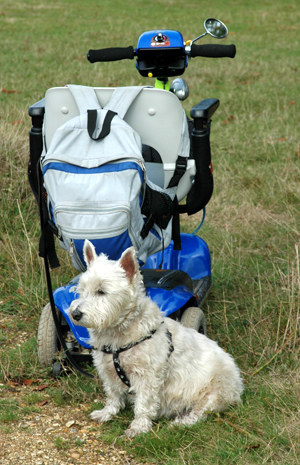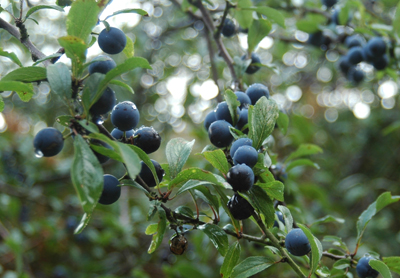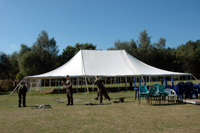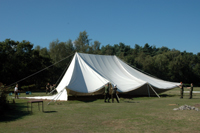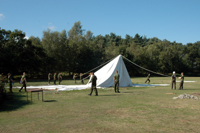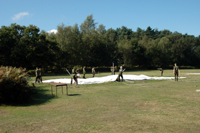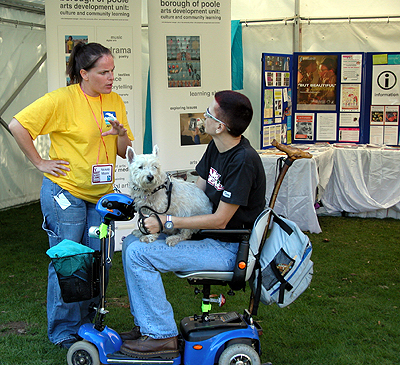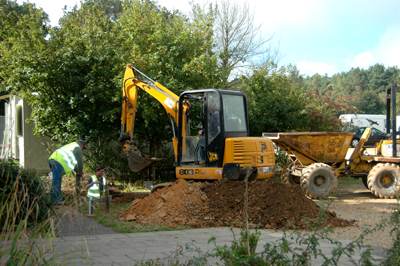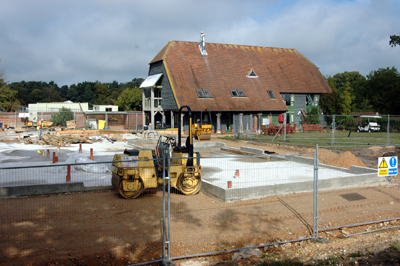Visit 7: 21 - 26 September 2006 As we leave for Holton Lee, the sun is burning down as fiercely as it was in August, as September shapes up to be the hottest one on record. It is so hot as to be uncomfortable while driving on the motorway, even when dressed only in shorts and T-shirt. It is, though, exciting to be returning after almost a six-week break, during which time I've travelled to Tobago to attend the wedding of one of my p.a.'s as well as working in London. Tony, too, is just back from his travels, although Trish is having to save up her holiday so that she can spend some prolonged time at university once term begins again. Genie is also hugely excited to be back, after a fairly dull few weeks for her - she sticks her head out of the window as soon as we turn down the lane, drinking in the smells at the same time as failing to notice the deer staring back at her!
I am pleased to see that the caravan has suffered no ill-effects from being shut up for so long, although it is listing slightly. Clearly our mole is still resident! The caravan is parked in the most obvious place for it within the orchard, but I am at a loss to understand why the mole favours the same spot. However, all of the mole hills in the orchard are beneath and around the caravan, with no sign of them anywhere else. As the mole was here first, there is no alternative but to arrange to shore up the caravan again and hope for the best. With any luck, the mole's presence will also discourage less desirable wildlife from moving in under the caravan during the winter. As usual, it has taken much longer than I anticipated to close the house, pack the van and travel down here, so it is almost four o'clock when we arrive. We've been further delayed by the Nat West cash machine at the M25 services, which broke down as soon as I put my card into it. This is one of those events that everyone secretly dreads every time a cash machine pauses for a beat during a transaction, so in a strange kind of way it's a relief that it's finally happened to me. In every other way it's an incredible nuisance, though, particularly as my local branch has closed down so I rely very heavily on being able to send my p.a. out with the card every time that I need cash or shopping. However, the service station manager was very helpful, fetching me a chair to sit on while we waited to see if the machine would spit the card out again, and finding me the local branch number when it didn't. I was less impressed by Nat West, who seemed to find it an effort just to tell me the number I needed to call to cancel my card, after informing me laconically that they throw away any cards which become the victim of their computer crashing. Somehow I am going to have to manage for up to a fortnight while the card is being replaced, but as there is nothing I can do about it, it seems pointless to worry further.
In any case, problems with computerised banking seem irrelevant when you are surrounded by the natural world. Autumn is just around the corner, and the intense colours of early summer are faded now, even though the sun is just as hot. The air is much clearer, too, than it was in the heat of July and August, and there is a new energy breaking through. The deer are much in evidence, having grown in confidence - I am told by Denise in the stables - as they get close to the rutting season. The days are noticeably shorter, and by the time that we have unpacked with the help of Trish, it is close to dusk. We just have time to greet some of the friends that we have made over the summer before the sun begins to set in a blaze of pinks and purples, much more intense than any sunset I have seen here before. We watch it fade behind Twin Oak tree field, where many of the deer have now gathered. It would be hard to think of a more beautiful sight, and it is very clear that the seasons are changing. The earlier nightfall also teaches me more about the workings of the caravan, as by seven thirty I have to put the lights on. In my ignorance, I had assumed that the caravan's electrical fittings all worked off the mains supply so long as it was connected to it, and I have been running a hook-up to the supply in the neighbouring garage. However, the fluorescent lights are now all very dim, and I discover from the manual that most of the fittings actually run off the battery as they are the wrong voltage to work off the mains. This also explains why the water pump is drawing so little water, which I had put down to the tank being nearly empty, and the dustbuster is not picking up, which I had put down to its filter needing cleaning. I am impressed that the battery has lasted so long, but at a slight loss to know how to get it charged. I am, though, confident that someone will be able to tell me, and in the meantime I have two mains-powered lights as well as a gas lamp to keep us going. The following morning, Friday, is the autumn equinox, and the weather has changed completely. It is still fairly warm, but the sky is over-cast, and all too soon the rain starts to pour down. We end up spending most of the morning in the caravan, much of it drinking tea with Derek, who is in charge of the organic garden, and looking at the photographs which Julie has taken over the summer of the different vegetables that he has grown. Derek's garden supplies most of the salad and vegetables for the people staying at the Barn, and we have enjoyed them too when we have been at Holton Lee. I have discovered that fresh organic produce really does taste different to the stuff served up in the supermarkets of East London, and have felt very privileged to be able to access the garden here.
Richard, the 'Green Team' volunteer who helped to run the music evening in August, then turns up to help me with the battery, having mysteriously discovered that I needed help on the Holton Lee bush telegraph. We discover that the compartment also houses a spare, but this is completely flat. I decide to take them both out for charging now, in case the main battery won't take a charge if it is totally exhausted. Richard nobly struggles out with them and leaves them in the foot well of the passenger side of my van, as a prelude to finding someone to charge them. Before I put the seat back, I notice a small switch between the external and internal TV aerial leads, apparently unconnected to anything else. I decide that it can't do any harm to move it to the opposite position, although by now I have given up hope of ever having an intelligible television signal here, and in any case, Derek has had to take down the aerial pole that he erected in August now that the winds have become stronger. For the rest of the morning I sit down with the laptop and continue editing my latest Bettany Press publication, Two Chalet School Girls in India. This is a fill-in novel to the famous Chalet School series of girls' school stories by Elinor M. Brent-Dyer, written by Priyadarshini Narendra who lives in India herself. There have been a number of fill-in and continuation novels published by fans over the past decade, following the publication by Bettany Press of Visitors to the Chalet School by Brent-Dyer's biographer, Helen McClelland. However, Priya's novel is unusual on two counts: it is the first 'Chalet' novel to be written by someone living outside the UK - although the books have always been popular with girls worldwide, both in English and in translation - and Brent-Dyer really did write a novel with this title and setting. However, the war intervened and the original was never published, and the manuscript was later lost. For this reason there is a lot of excitement about the book, and the file of pre-orders is growing thicker by the week.
There is a short break in the weather in the afternoon, so I go over to the other gardens at Holton Lee, which are run as a training project for students with learning difficulties from Bournemouth and Poole College under the guidance of Dave Pollard. Dave has been successful in arranging sponsorship from a local building contractor, Rok, and their suppliers, to create a working show garden behind the Stables Studios, bordering the Riding for the Disabled stables. The garden, which will include accessible paths, decking, raised viewing platforms and seating areas, will enable the students to get more work experience as well as providing a facility for everyone using that end of the site. I just manage to photograph the work in progress before the rain starts again, and I have to beat a hasty retreat before the camera gets wet. On the way back to the caravan I photograph the sloes in the lane - Derek and Julie have detailed plans afoot for making sloe gin in readiness for Christmas, which I must admit to having a certain interest in too. I spend the rest of the afternoon in the office with Trish, as the software for the Calm database, which will form the basis of the virtual archive, has just arrived in the post. We are successful in installing it with just one call to the helpline - since we then discover that a line of the installation instructions is effectively missing, we decide that this is pretty good going. Obviously to admit this marks me further as a geek, but it is very exciting to see the Calm logo and the front page coming up on the Holton Lee server, after first seeing it when the sales rep demonstrated the software to us at the beginning of July.
We are also struck anew by how very inaccessible the design for the programming interface is, but fortunately we will be able to customise the users' interface completely to make it as accessible as possible. We have arranged to feed back any and all access problems to the Calm developers, so hopefully one day Calm will be programmable as well as usable by people with a wide range of impairments. We decide that we will not begin the customisation process until we have designed the templates and decided on the database categories that we are going to use for the archive. However, Hayley, our trainee, starts next week, and will immediately begin to research the categories that other collections use. We will then have a training week in October, where I will work with Trish and Hayley on the designs and we will have a training session with the Calm developers where they will help us to put these into action. On the way back from the Farm House, Genie and I inspect the site where next autumn the NDACA building should be progressing rapidly. In the soft earth at the side of the site, which is pitted with rabbit burrows, I pick up a small glass jar, which looks like a paste or cream jar. This is close to where Karen found the old milk bottle during our last visit - Derek tells us that the M&P on the bottle stands for 'Malmesbury and Parsons Dairy' - so I assume there is some kind of connection: most likely there was a rubbish heap here, although it could have been an outbuilding. The old dairy, though, was close to where the Stables Studios now are, so the finds can't mark the site of this. Later I return with Julie and she finds another small jar of a different design, although sadly this is badly chipped.
I had hoped to have a barbecue this evening, to mark the equinox and the end of the summer. However, it is far too wet underfoot, although the rain has stopped at last. Instead, Wally and Denise from the (Riding for the Disabled) stables join us for tea in the caravan. We enjoy swapping stories, before night descends and they leave for a well-earned break over the weekend. After they've gone, I switch the television on in a triumph of hope over experience. To my amazement, I can pick up four out of five channels - even with the aerial now lying on the ground. I have absolutely no idea what function the switch that I flipped over serves, since it is definitely not a signal booster, but if anyone else does, please email me to satisfy my geek curiosity. It seems a shame in the circumstances that the programmes this evening are absolutely dire! Around midnight the sky is lit up by flashes of lightning, and the silence is quickly broken by peals of thunder that reverberate across Poole Harbour and leave the air vibrating. It is as if the season is literally changing with the first night that is longer rather than shorter than the day that preceded it. Genie has three pet hates - fireworks, thunder and the vet - and is extremely - and vocally - unhappy about it, so we do not sleep until the storm has broken. If it wasn't for her distress, though, it would have been quite an enjoyable experience - being in the caravan creates far less of a barrier between humans and the environment than bricks and mortar do.
Saturday morning, though, is beautiful, with bright blue skies and hot sunshine. But there is a noticeable change in the quality of the light: it is clearly the first day of autumn, just as Thursday was clearly the last day of the summer and Friday was a strange in-between time. It is quite consciously a day when it is a pleasure just to be alive - even while thinking how clichéd this is! Holton Lee's charms are extremely obvious today, and the very special place it has in the hearts of many of its staff, volunteers and visitors is completely understandable. For disabled people, this is heightened by its accessibility and the feeling of all-round well-being that it engenders. It is also obvious why the site was once host to the Post Green Christian community, the founders of Holton Lee, and why spirituality (but not religion) is one of the four founding principles, along with the arts, the environment and disabled people/carers. Tony has arranged for the army to come in today, as part of their occasional visits to clear ditches, build and maintain accessible pathways and so on. This morning they will be taking down the marquee that sits next to the Barn from May to September and acts as a base for outdoor events, as well as clearing the ditches before the autumn rains set in properly. Tony joins in with gusto, driving Holton Lee's 'Mule' backwards and forwards from the Dutch barn by the artists' studios where the marquee's seating and barbecues will be stored over the winter. Infected by their enthusiasm and the energy of the day, we decide to prepare for the winter too, by washing down the caravan and checking and storing the outdoor equipment as appropriate. The sun is so hot that it becomes a positive pleasure to put on shorts and a bikini top and spend the rest of the day playing with water. Thankfully there is no hosepipe ban in the south west - the London ban has made it very difficult for me to keep my garden alive over the summer, as it has for many disabled people who cannot carry watering cans.
By the evening we are exhausted, and are pleased to crash out on the beds and watch the television - at least until the aerial falls off the fence where I had balanced it, and I realise that I still have to work out how and where to fix it properly. Needless to say, it gives the best signal when I am holding it . . . At 2am we are wakened again by thunder - or initially, by Genie's whimpering, as she hears it coming before it breaks overhead. But the following morning it is sunny and hot once more, and we head to Upton country park - a mile or so away - for an arts festival run by Poole council. This is very well-attended, with a band playing cheerfully on the stage while a number of small marquees host participatory family arts activities. Disability arts are well integrated into the whole, with performances by the Signdance Collective, an exhibition by Fresh Talent, whose members all have learning difficulties, and British Sign Language (BSL) interpretation available for the story telling sessions and the workshops. I meet the organisers, the arts team from Poole, and we agree to meet with Tony to talk about NDACA later in the autumn.
From Upton country park we move on to Rockley Point and the watersports centre there. Rockley is a fair distance by road, but is actually very close to Holton Lee by water. Poole Sailability is having their end-of-season barbeque, and Dave Pollard, a former chair, has arranged an invitation for us. If all is well and the funding is confirmed for NDACA, I will be back next year as a member. After a long period without sailing, I was delighted to discover Tideway Sailability at Surrey Docks this year, and have been sailing regularly over the summer when I've been in London. This summer has been so full that there has been no time to sail when I've been at Holton Lee, but it would be great to go out regularly another year. I am also very keen to view Holton Lee from the water, and hope to be able to arrange this before next summer. The club is in a beautiful position, and I can imagine that sailing here will be a great experience. Poole Harbour is the second largest natural harbour in the world and is a mecca for all kinds of watersports, having all of the advantages of the sea while being more sheltered than the English Channel. The sailors are very friendly and make us extremely welcome, while the barbecue is delicious. Genie is still upset after the storm the night before, but makes friends with Dave's daughters and is further mollified by pork from the barbie - until a large dog bounds out of the water and spooks her, after which she is not really happy until she gets back in the van. My only negative is discovering that my scooter will not work on wet sand - I am so used to it performing well in every situation despite it only being meant for shopping that I am rather taken aback. Later we return to the caravan via a garage, where we stop to pick up the Sunday papers, and spend a lazy and exhausted evening reading and watching the television.
On Monday it is back to work, writing this blog and meeting with Tony to plan the autumn's activities. I will be coming down monthly until Christmas, to project manage the development of the virtual archive, as well as to report on the progress of NDACA and to continue to plan the art work which will be installed in the new building. October will realistically be the last time that I can sleep in the caravan, so we arrange that I will use part of the flat over the Farm House over the winter, as the Barn will be shut for five months from the end of October while it is being extended. I go to view the progress of the extension, and am impressed by how much has already been achieved. Once complete, it will double the number of rooms available, as well as enabling the dining facilities to be moved to the ground floor. The new rooms will be ensuite, and double rather than single. The Barn is so popular with disabled visitors that it is often booked up months in advance, so the extension of the facilities will be extremely welcome to many regular guests as well as to potential visitors who have been unable to book accommodation in the past. It will also enable visitors to NDACA to book on-site accommodation more easily than they could if the facilities remained unchanged.
At the back of the foundations of the extension, on the border of Celebration Field, I discover a small stone marking the spot where Faith Lees' ashes are buried. Faith was a Christian philosopher and spiritual leader who co-founded Holton Lee, and before that the Post Green community - the site was originally owned by the family of her husband, Sir Tom Lees, who created the Holton Lee Trust. Faith's memory is treated with great love and respect by many people who remember her at Holton Lee today, and the stone states simply: "Her ashes lie here. Her vision is all around you." I feel very moved by this, and am glad that I have found it. After work, we manage to have our barbecue - probably the last time that we will be able to cook outside this year. Wally and Denise from the stables are able to join us, although Trish is currently in Wales and Tony has had to leave early to drive north, while Derek has other commitments. However, we enjoy ourselves thoroughly, while watching the deer gathering in Twin Oak Tree field as the sun sets. Later in the evening, for the first time that I have been coming down here, the stars are out in force. Holton Lee does suffer from its proximity to Poole, in that the light pollution affects the night sky. But the sky is so clear tonight that the view is still magnificent. We have folding chairs with leg rests for sitting outside, and get them out so that we can lie back and look at the constellations in comfort. It is clear that each season will bring with it new experiences of Holton Lee, and I realise again how lucky I am to have this job.
Click here to read the next entry Click here to return to the blog entries Click here to return to the top of the page All contents © 2006 |


